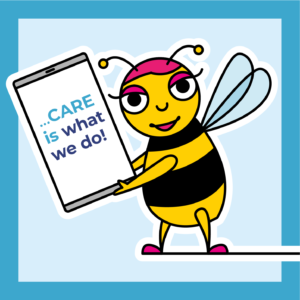Health and social care have struggled with the move to digital care management for more than 30 years. The lack of a single digital electronic patient record system in the NHS, despite considerable financial investment over the years, has set a low benchmark for digitalisation across the wider health and social care sector.
 The Department of Health and Social Care nevertheless have the aspiration that by March 2024, at least 80% of social care providers have a digitised care record in place that can connect to a shared care record.
The Department of Health and Social Care nevertheless have the aspiration that by March 2024, at least 80% of social care providers have a digitised care record in place that can connect to a shared care record.
This aspiration is important for two key reasons, the first of which is that is demonstrates a firm commitment to the social care sector which has historically not always been the case, and secondly it talks to the desire to modernise a sector which has often been the Cinderella service in health and social care provision in the UK.
Besides the macro level reasons for digitalisation, there are many reasons individual care services need to consider digital care management software and other records, many of which will be explored here.
Making life easier
There are many common-sense reasons that social care providers should strongly consider the move to digital care management, this includes the simple fact that they are a lot safer, easier to read, access, audit and share than paper records. But of course there is nothing quite like the feel of paper and the reassurance of something tangible in your hand…. that is of course until you lose it, tear it, spill coffee on it or plain and simple just can’t read it!
None of these disasters are a consequence of digital care management record keeping where the digital record is regularly backed up and can be recovered and restored following any incident.
Digital is more secure
With developments in cloud-based storage and increasingly cheap and easy access to mobile and conventional broadband the argument about access to the care plan and safe storage is a non-starter. Digital care plans are much easier to store safely than those on paper and:
- Need less space.
- Are more difficult to lose.
- Are easy to archive.
- Can be accessed readily.
- Are more difficult to leave lying around, so breaching data protection regulations.
Digital care management systems use password protection or other forms of digital safety to ensure that only designated individual have access to them, making them at least as safe as paper records.
Sharing access with other professionals
One key advantage of using digital care management and support planning is that access to the records can be shared. One of the things the COVID-19 pandemic has taught many of us in health and social care is that remote access and shared digital working is a god send when the opportunity to work face to face is denied.
When identifying what good looks like for digital care management, the CQC recognise how digital care records enable providers to deliver care which has better outcomes for service users, https://www.cqc.org.uk/guidance-providers/adult-social-care/what-good-looks-digital-records-adult-social-care.
Better outcomes are invariably associated with the ability to maintain and share records in a meaningful and accessible way. Put simply better records mean better care.
Among the professionals who could benefit from access to shared digital care records are social workers and GPs who not only can see what is going on with a service user, but can also comment and leave messages for staff, and service users (see later) within the system. Secure digital care management therefore serve to improve communication between people providing care, which has to be a good thing.
The Social Care Institute for Excellence identifies how electronic care records not only provide real time access to all the care teams involved in the care of a service user, but that electronic care records can travel with the service user, https://www.scie.org.uk/integrated-care/research-practice/enablers/information-sharing. This is game changing in terms of providing truly holistic, multidisciplinary care, which without the ability to share records is can only be a lip-service provision.
In one study, the use of a digital care management system in nursing homes led to improved health and functional outcomes for elderly residents especially around preventing deterioration in the ability to undertake the activities of daily living.
While the use of technology in the UK is far from the ideal achieved in this randomised controlled trial, the proof of concept suggests that the benefits of using digital care management technology for service users are measurable.
Real time data
One of the benefits of using digital is that the carer can, with a mobile device in their pocket, record what they are doing in real time. Real time data capture does two things:
- It provides reassurance to managers that care is being provided at the times identified in the plan of care.
- It enables seniors to identify when someone’s needs are changing or not being met, e.g. if the fluid intake target is not being met at midday, there is the opportunity to increase a service user’s fluid intake during the afternoon.
Having real time data to hand contributes to continuity of care. In the policy paper ‘People at the Heart of Care: adult social care reform,’ the DHSC, identify how digital records enhance the transfer of care and handovers ensuring staff have access to the most up-to-date information about the condition of service users. Such records are seen by the DHSC to be timelier, joined up and accurate.
The Royal College of Nursing reminds nurses, and other care staff, how contemporaneous record keeping is a requirement of their registration and can serve to protect them should their practice ever be called into question.
Easier to audit
Digital care management records are easier for the manager to audit than paper ones. Many platforms collect and collate data in to reports the manager can use to identify gaps in the service, or trends which need attention.
For example, a trend in the falls for a particular service user identified through digital incident and accident reporting within a digital care management system enables the manager to instigate a review of their care plan and risk assessments.
Using digital care management enables care staff to record, with some degree of accuracy, how long they take to provide care to an individual. Collated, these figures enable the manager to identify the staffing time needed to provide care to their service users and create accurate dependency models as well as costings to commissioners.
Such dependency measures feed into objective staffing models which have previously proved to be unreliable and inconsistently applied.
Person-centred
 One of the last things people think that digital care management can be is more person-centred than paper, but they would be mistaken. The ability to provide 24hour a day seven days a week access to care records means service users, and their designated relevant persons, can review their care plans and be reassured about the provision of care whenever they want.
One of the last things people think that digital care management can be is more person-centred than paper, but they would be mistaken. The ability to provide 24hour a day seven days a week access to care records means service users, and their designated relevant persons, can review their care plans and be reassured about the provision of care whenever they want.
Together with the facility for service users and their supporters to message carers, this provides a tool for real time communication and scrutiny which is one hallmark of person-centred care.
Another hallmark of person-centred care is that the care plan is derived with the input of the person the plan is about, the ability of care providers to enact this strategy is clearly improved where the individual, and those important to them, have easy access to the care record.
Some providers are shy of the facility to share ‘their’ care plans with service users and their families, but providers who are outstanding, or striving to attain outstanding ratings, will see this as an opportunity to show case their care and to drive up the standard of record keeping where this need to occur. Let’s remember it is the service user’s care plan and not ours!
Regulation
With the new models of inspection and regulation, the CQC need improved access to records to support its ongoing programme of remote monitoring of care providers. Requests for evidence, part of this monitoring approach, are easier for managers to comply with if the information is already on a digital care management system, making relationships with inspectors easier to navigate.
Making the change
Skills for Care when identifying the reasons social care providers should go digital lists the following reasons in terms of enabling the social care workforce to:
- Work smarter and more productively.
- Ensure that data is accurate and relevant.
- Use technology as part of their learning and professional development.
- Use technology to support and record achievements related to recognised standards and qualifications.
- Develop the knowledge and skills that enable them to identify new opportunities for technology to be used as part of someone’s care and support package.
- Maintain privacy and confidentiality.
- Actively share information safely and securely, within the law and local protocols.
Of course where there is change there is resistance, there is nothing new in this and neither is this phenomenon peculiar to the adoption of technology. Many care staff when faced with the prospect of moving to digital care planning and care management systems will claim that they don’t do technology and don’t understand it.
These same people will later post on their social media accounts that they are concerned that their manager wants them to use digital care planning at work, whilst they order their weekly online shop or monitor their daily mileage using a fitness app.

The truth of the matter is we are all more technologically savvy than we give ourselves credit for. The interfaces of modern care management systems are intuitive and simple to use and most care staff will learn the basic of them in only a few minutes.
Care staff also identify that the use of digital records will add to their work burden, this is simply not the case. The DHSC (2021) identify how the use of digital technologies in care settings should free up time for more human interaction. There are a number of reasons for this which might include:
- Digital are easier to read than handwritten records.
- The record can be accessed from any enabled device – where there are paper records there is just the one record.
- Some care interventions can be recorded at the touch of a button.
- Several staff can enter or read the data pertaining to a service user simultaneously.
Other benefits
As well as care planning, many care management systems also offer additional elements to their products which make the whole business of running a social care provision easier as well as improving compliance. For example, many offer access to products such as:
social care provision easier as well as improving compliance. For example, many offer access to products such as:
- policies and procedures,
- training
- electronic Medication Administration Records (eMAR)
all of which enable frontline social care workers to access everything they need to undertake their roles as well as to train and develop while doing so.
Some digital care management have additional benefits for the service manager offering tools such as audit, supervision and appraisal and training records and trackers, such as here at Careis, https://www.careis.net/.
There are also many providers providing office solutions for rota scheduling, payroll and holiday functions. These additional tools not only make the job of the manager easier through recording activity, but they also schedule the activities, provide reminders and can be used to demonstrate compliance.
Any provider who still is not convinced, might consider the benefits of being able to access a dashboard of data which identifies issues such as incident reporting, missed audits and interventions as well as providing action plans which can be used to support and develop the registered manager and nominated individual function.
Conclusion
While there is no one single digital care management system which will provide everything that every social care provider could want, the market for digital care management systems in social care is well provided for in the UK.
Where there are not digital care management systems in place, or where the team are not happy with their current digital care management system, nominated individuals and registered managers should, together with their staff teams, consider what they need to enhance their service. They should then explore the market and look for a digital care management system provider which best meets the needs they identify within their service.
